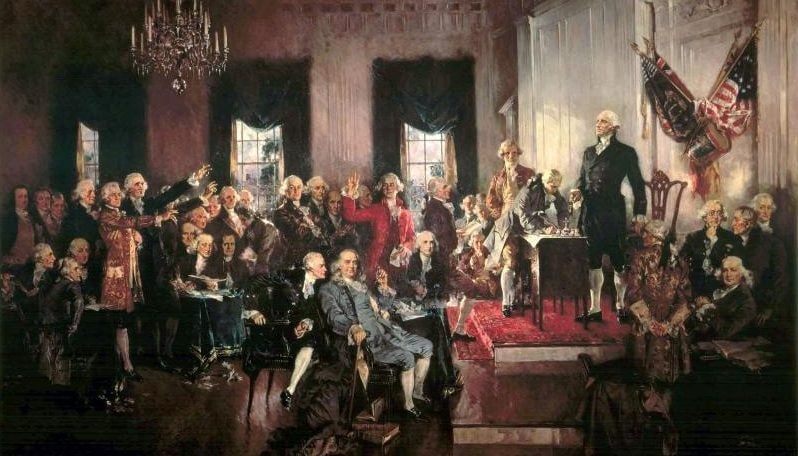The US Constitution allows for impeaching presidents who have “rendered themselves obnoxious”
Back in the day, British kings claimed that God chose them for the throne, and no one could remove them… at least not legally. So in 1787, at a convention in Philadelphia, the framers of the US Constitution debated whether American law should include a process for removing presidents who had “rendered themselves obnoxious,” in Benjamin Franklin’s words.


Back in the day, British kings claimed that God chose them for the throne, and no one could remove them… at least not legally. So in 1787, at a convention in Philadelphia, the framers of the US Constitution debated whether American law should include a process for removing presidents who had “rendered themselves obnoxious,” in Benjamin Franklin’s words.
He suggested extending impeachment—a Roman legal institution allowing removal of senators but not emperors—to the Executive branch. Franklin said it was only fair to air accusations of misconduct, present evidence, and provide an opportunity for vindication. He believed impeachment could spare lives by preventing presidential assassinations.
The suggestion was approved, and devilish details—like what’s a chargeable offense, who makes accusations, how they’re proven, and what the consequences are—were worked out, mostly. The Constitution does provide for impeachment, although no president has ever actually been removed from office through this process… and what qualifies as an impeachable offense has never really been crystal clear.
Impeachable offenses aren’t specifically listed
Impeachment lets the government investigate and remove corrupt officials. But there’s no list detailing precisely which offenses qualify for this process. For example, the framers discussed and discarded the term “maladministration”—James Madison thought it was too vague. They ended up providing the following general standard in Article II, section 4, of the Constitution:
The President, Vice President and all civil officers of the United States, shall be removed from office on impeachment for, and conviction of, treason, bribery, or other high crimes and misdemeanors.
Since 1787, debate about what exactly counts as impeachable hasn’t abated. It’s still not obvious. There are at least four positions on this question, probably more.
Some claim any act offensive to the executive office qualifies as impeachable, while others say only an indictable crime does. Misdemeanors (not indictable technically) are in the plain language of the law, which many believe is evidence that any criminality suffices. Yet another view is that for an offense to be impeachable, it must be criminal and related to presidential duties.
Generally, illegal acts—committed prior to or during the presidency—that seriously endanger the office’s integrity, subject the executive to impeachment proceedings.
House members get the ball rolling
Any one legislator in the 435-member House of Representatives can initiate impeachment by introducing a resolution, like they would any other bill, or they can resolve together to begin an inquiry. Either way, the House Judiciary Committee then investigates and decides whether to pursue articles of impeachment in the House.
If so, the committee reports its findings and a vote is held. Only a simple majority vote is needed to adopt articles of impeachment in the House. This essentially tells the Senate to hold a trial that may remove the president.
Senators hear an impeachment trial
To actually remove a president takes a conviction after trial. The House chooses judiciary committee members to act as prosecutors, and a proceeding is held before the 100-member Senate.
The Chief Justice of the Supreme Court presides, making rulings on motions, objections, the admissibility of evidence, and the like, while senators act as a jury, considering what’s presented. The president can represent himself or hire any counselor desired.
Conviction is based on a 2/3 majority vote. Assuming a conviction, which has never happened, the Supreme Court could hear a presidential appeal; the Chief Justice would be recused and the proceedings would be reviewed. No one’s gotten anywhere near that far along in the process.
Conviction consequences are limited
A conviction removes the executive, but that hasn’t happened yet in presidential history. Theoretically, the Senate can also vote to bar a convicted official from ever holding a federal office again, but that stage hasn’t been reached either.
The Senate cannot impose a criminal conviction on the president. Any criminal charges and other consequences would have to arise separately, and be prosecuted in courts.
There’s also been much debate about whether the Senate can impose a punishment short of removal, like censure, an issue which arose during Bill Clinton’s impeachment proceedings but wasn’t finally answered.
A history of presidential impeachment
Clinton was impeached in 1998 (paywall) for perjury and obstruction of justice during government investigations. He wan’t convicted in the Senate, however, and stayed in office based on this acquittal.
Richard Nixon, first elected in 1968 and reelected in 1972, resigned ahead of a likely impeachment. Based on Watergate—a scandal over the the Republican president’s involvement in the cover-up of a break-in at Democratic National Committee headquarters—the House Judiciary Committee adopted impeachment articles against him in February 1974. After much wrangling over records, Nixon quit, the first and only president to do so. But he wasn’t impeached.
The 25th Amendment dictates presidential succession, and Nixon was replaced by his vice president, Gerald Ford, who in 1973 replaced the original Nixon VP, Spiro Agnew, after his resignation. Ford served as president from 1974 until 1977.
The only other president impeached was Andrew Johnson in 1868. He was accused of illegally replacing a general, among other claims, but was acquitted in the Senate and remained in office.
It’s deliberately difficult to oust a president
Impeachment is rare, and conviction even more so, because it’s not supposed to be easy to remove a president elected by the people. Basically, impeachment exists as protection, just in case things go really wrong, or seem to. If it was too easy to remove a president, the government would be in constant conflict rather than operating a nation.